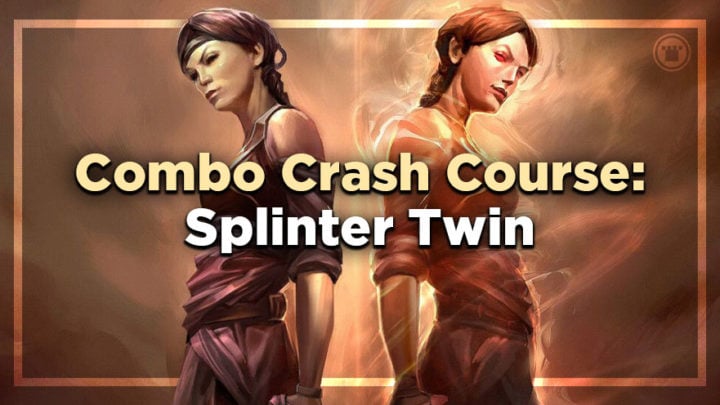For many Magic players, combo decks offer the most exciting and interesting way to play the game. They appeal to us on many levels: the cheeky thrill of “getting away with something”, the intellectual satisfaction of winning at one stroke, as though cutting the Gordian knot. Combos also embody the creativity and discovery inherent to CCGs, giving players the chance to demonstrate their routine of dazzling and novel tricks like… well, a magician.
But the complexities and subtleties of combo decks can also become a barrier for newer players trying to find their feet in Magic’s subculture. Prominent combos heavily influence card choices and gameplay even in the casual Commander metagame, and inspire swathes of in-jokes and card comparisons which assume them to be common knowledge.
Welcome to our new article series, Combo Crash Course. We’ll be explaining Magic’s most essential combos, breaking down not only how they function under the rules, but how they came to be popularized in the community and their impact on various formats through the years.
But which combo to address first? How about the deck that’s become practically synonymous with two-card combos?
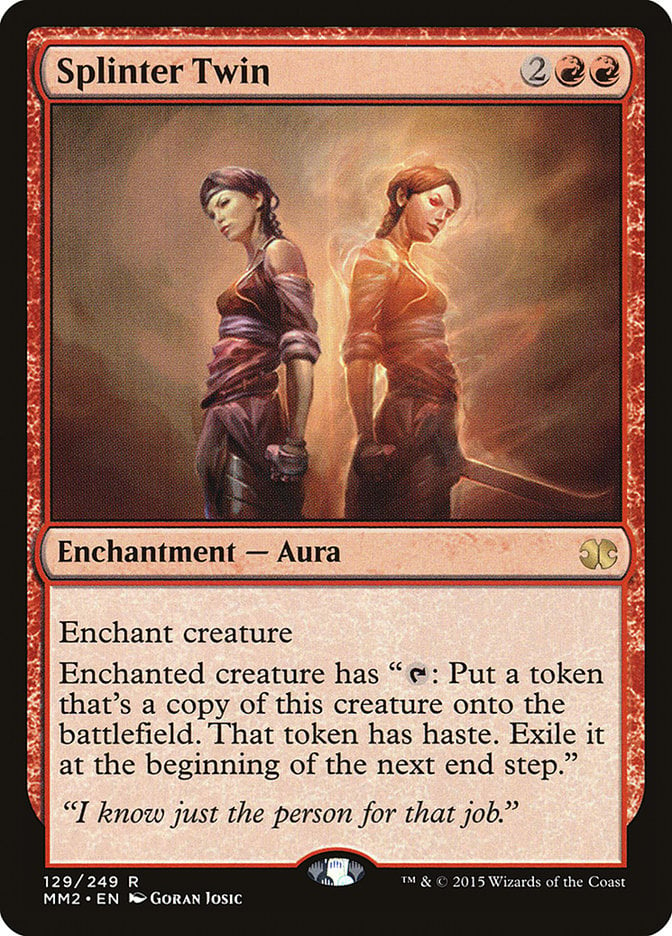
WHAT IS SPLINTER TWIN?
In Magic parlance, Splinter Twin is a UR combo-control deck that was prominent in the early years of the Modern format. The namesake card gives any creature the ability to Clone itself for 0 mana, just by tapping the creature. When applied to creatures with an ETB untap trigger, you can deal infinite combat damage in a single turn. Each activation of Splinter Twin creates a new copy of Pestermite or Deceiver Exarch with haste, whose ETB trigger can untap the original enchanted creature — as clean and simple a loop as you’re ever likely to see.
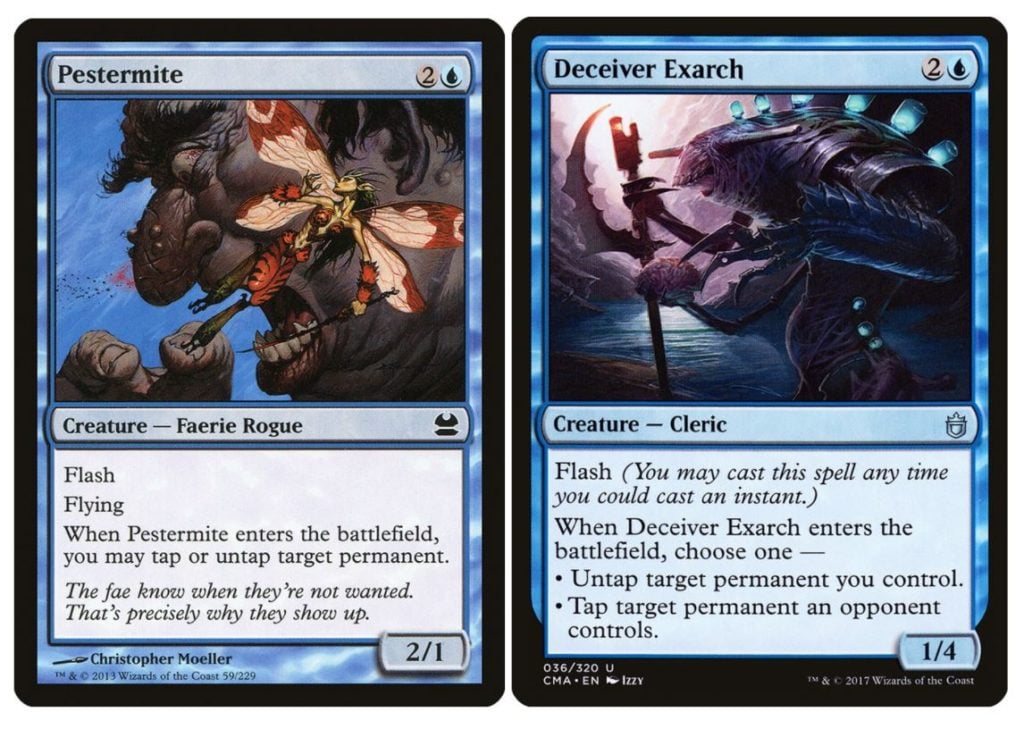
Both creatures can be flashed in on the opponent’s end step before your combo turn, and Splinter Twin itself is the most expensive piece at just four mana. Twin decks can therefore threaten a “one-turn kill” very early on, or use spare mana to protect each piece with countermagic. This forces opponents into pressuring the Twin deck before it sets up the combo + protection, while also needing to hold up instant-speed interaction at all times to prevent a combo attempt.
HOW TO BEAT IT?
The weakest point of any Splinter Twin deck is its namesake card. Since Splinter Twin is an Aura, removing the enchanted creature will take out both combo pieces. However, the timing of such a removal spell is tricky. As with most combos, you’ll need instant-speed removal to have a chance; and most likely, you’ll need to remove the creature in response to Splinter Twin being cast. If you try after the Aura has resolved, be ready for your opponent to attempt to “go off” in response; if your opponent already has infinite 1/4 tokens in play by the time your Path to Exile resolves, then it won’t do you much good. Fog effects or similar options like the tap-down mode on Cryptic Command can buy a turn, but they are by no means a good solution.
You can try bringing a second removal spell, to cast in response to the Twin player’s responsive combo attempt before the first activation can resolve. But even if neither removal attempt meets a counterspell, Twin can also drop in a spare Pestermite or Exarch at instant speed to untap their enchanted creature, allowing a second attempt at infinite tokens. Do you have a third instant-speed removal option at the ready? What about if that third spell meets a Remand? Will you have the mana to play it again?
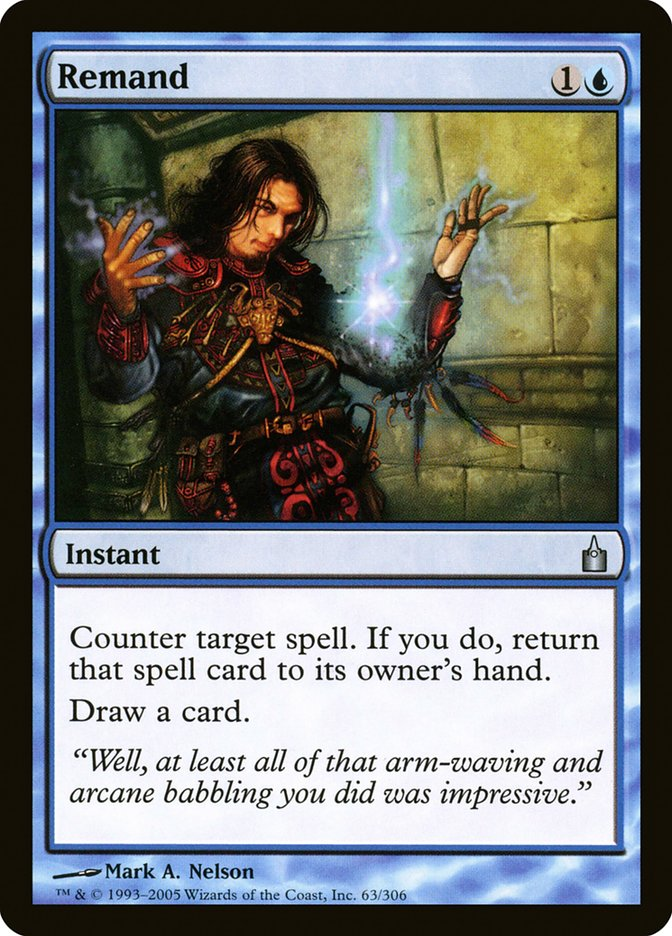
Clever Twin players will also use Remand to save the namesake Aura in response to a removal spell on the target — since the target is the easier piece to replace. Most successful incarnations of the deck in Modern also maindecked hyper-efficient anti-interaction tools such as Dispel and the removal-eating Spellskite, further stretching their opposition’s ability to handle stray Exarchs.
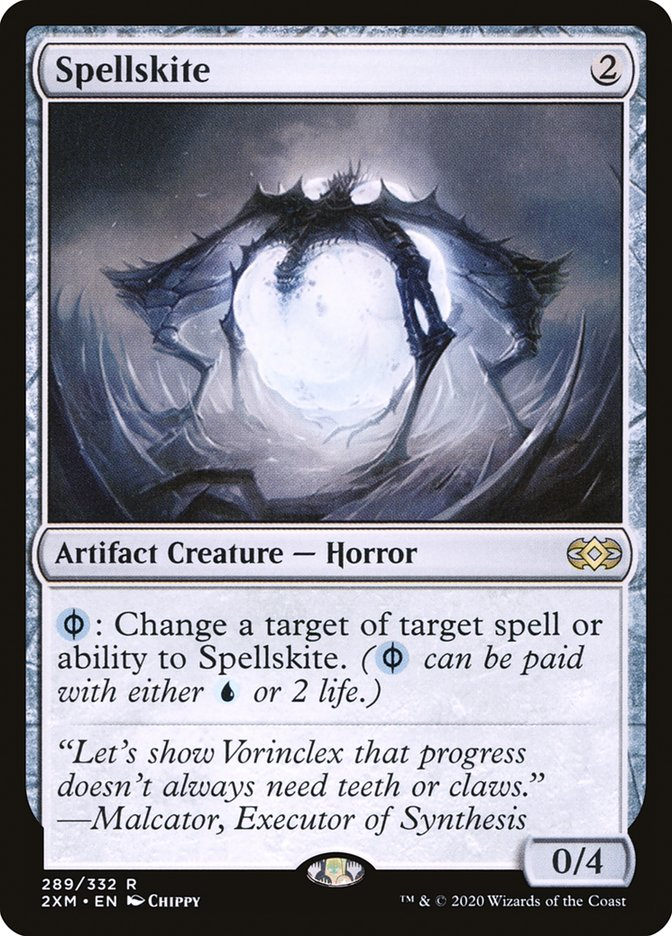
As you can see, for a straightforward A+B combo built around a famously vulnerable card type, Splinter Twin is anything but fragile. Permanents with disruptive static abilities such as Torpor Orb, Gaddock Teeg or Linvala, Keeper of Silence can test the Twin player’s access to offensive interaction – but all it takes is a flexible bounce spell like Unsubstantiate to create the momentary window they need to unleash their combo.
THE POWER OF PERMANENTS – TWIN & TIMING
Splinter Twin became an absolute pillar of Modern and fan favorite for years. It functioned less like a traditional combo list and more as a win condition for UR Control. The deck was so successful that it quickly became a yardstick for all future combo-control archetypes, in any format!
Several factors make Twin an ideal combo-control wincon. Being a strictly two-card combo means few slots are diverted from useful interaction — a perfect fit for the overall deck building philosophy of control. Their low mana cost and the rare flexibility to deploy each piece on different turns makes it far easier to bring protective counterspells into the equation, letting the deck punch through possible defenses.
In fact, that versatile timing even extends to the final step of “going off”: activating the Splinter Twin tap ability to begin the chain of token creation before the lethal attack. Because both the creature and Aura are permanents, any attempt to let the Twin player “overcommit” before playing interaction is a risky business; they can just stop and wait to recoup all spent mana before advancing the combo further. The only timing restrictions on Twin are the sorcery-speed casting of the Aura, and the need to “go for it” in your pre-combat main phase in order to attack. Compared to other famous combo decks of the era, like Storm or Eggs, that’s an impressive amount of freedom; this, along with the low mana value of its cards, helped Splinter Twin achieve supremacy over the Modern format from its very beginnings.
THE DEFINITIVE MODERN COMBO DECK
Splinter Twin achieved notoriety almost entirely through its exploits in Modern, as both format and deck broke into the mainstream at the same time. PT Philadelphia 2011 was the world’s first chance to see what Modern looked like at the highest level of competition. And it turns out that what competitive Modern looked like… was Twin.
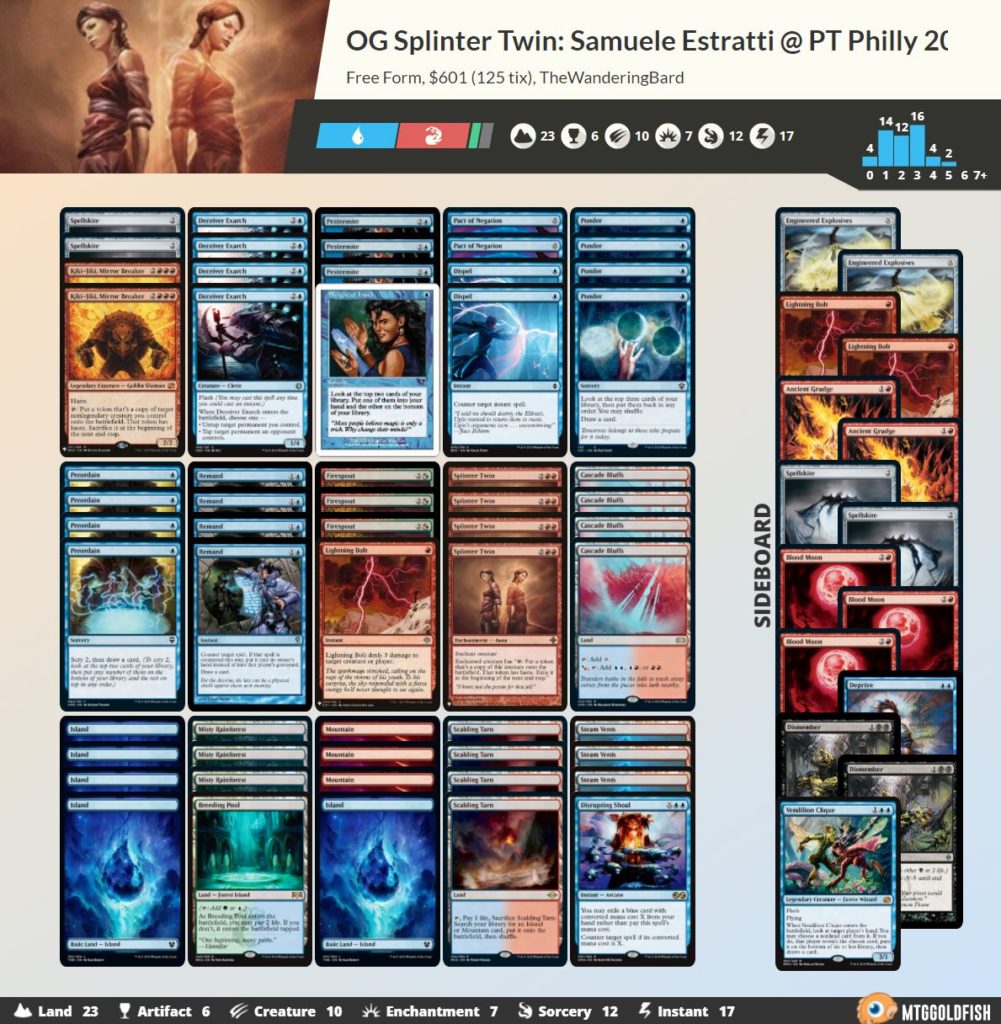
Italian Samuele Estratti proved Twin to be the superior combo list in a format packing Pyromancer Ascension Storm and Blazing Shoal Infect. Fellow Italian and Twin pilot Alessandro Portaro proved it wasn’t a fluke by joining him in the PT Top 8. Estratti’s finals run included triumphs over Storm, Affinity and the disruptive aggro of Josh Utter-Leyton’s Zoo.

All of Twin’s strong suits were on display in these games; the non-combo defensive utility of its creatures, its superiority in counterspell wars, the huge edge from being able to develop a combo one card at a time while holding up interaction, the mana base to board in Blood Moon without breaking a sweat. The official event coverage is fascinating as ever in hindsight: Frank Karsten, writing a piece on “Answering the Modern Format” as reflection on the weekend, had already identified the biggest struggle with answering Splinter Twin: the blue combo deck would always be able to interact back with something more efficient.
“Interestingly, once the metagame switches to Torpor Orbs, the Splinter Twin players will cut their Dispels for Echoing Truth and the same answer-for-your-answer cycle may start all over again.”
But even Karsten seemed to undersell the dominance Splinter Twin would go on to achieve in the following four years.
THE MOST CONTROVERSIAL BAN IN MAGIC
URx Splinter Twin became one of the true pillars of Modern through a period of relative stability in its early years. Alongside Tron, Primeval Titan ramp, Burn and Affinity, the combo deck was omnipresent in Top 8 results across events large and small. It won more than its fair share, with major trophies at the 2011 World Magic Cup (for Makihito Mihara & Japan), GP Antwerp 2013 (for Patrick Dickmann), PT Fate Reforged (for Antonio De Moral León) and 2015 GPs at Vancouver (Dan Lanthier) and Pittsburgh (Alex Bianchi). Few decks in history can boast such a resume, even in non-rotating formats like Modern.
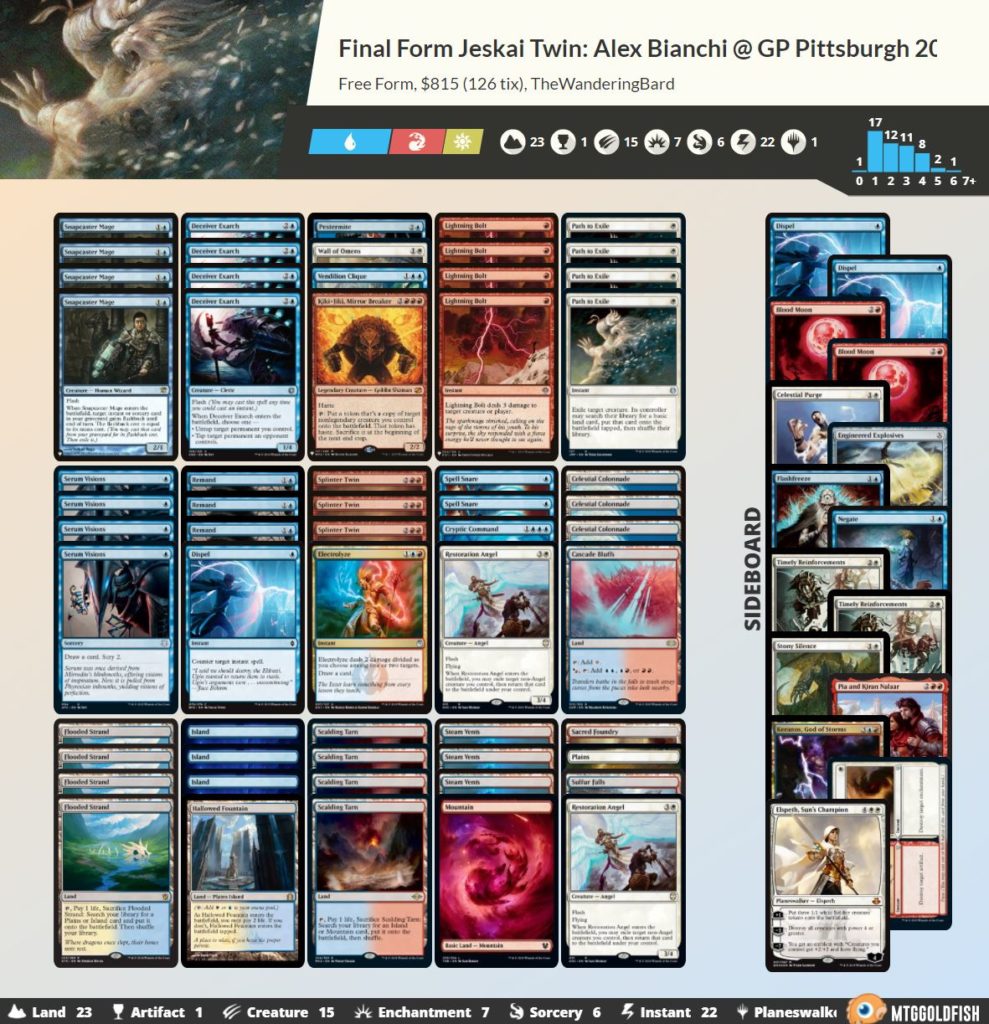
And across all those huge events and years of new sets, the game plan of the deck remained consistently lethal: interact with efficient blue counterspells and red removal, and drop the combo at the first sign the coast is clear. The biggest innovations were in an occasional splash color – Bianchi’s GP Pittsburgh list was Jeskai, for example – but it never felt like anything but the same deck. And eventually, more and more of the community got frustrated by the same deck winning.
Splinter Twin had already seen many of its fellow frontrunners in Modern fall to targeted bannings after winning a little too much: first Blazing Shoal and Cloudpost after barely a month of Modern’s existence, then Punishing Fire and Wild Nacatl to hobble Zoo. Stan Cifka single-handedly got Second Sunrise banned after a single dominant run with his “Eggs” deck, which may well deserve its own Combo Crash Course at some point. In 2015, Birthing Pod was banned, cutting down Twin’s most prominent combo rival and bringing further heat onto the UR deck in turn.
But Splinter Twin and its two pet creatures eluded that fate, with WotC instead bringing the hammer down on various cantrips and accelerants supporting the combo. The logic was that Splinter Twin itself wasn’t an especially broken card — it was the UR combo shell which gave it power, and banning Twin would simply see one of the other combo win conditions in those colors advance to take its place. Besides, supporters argued, wasn’t this a good sort of deck to have in the Top 8 of tournaments? Twin was championed as “the best of the fair decks,” a counterspell-wielding constable keeping Modern Magic recognizable against non-interactive gameplay. It’s hard to argue that interactive Magic is more interesting than two linear decks drag racing, and Twin both demanded interaction from opponents and packed plenty itself.
In some respects, this argument was never resolved; it rages still to this day, as you can discover yourself by searching “unban Twin” on any social media site or Magic community. But in a more real and competitively-relevant sense, the argument was resolved by the DCI announcement on January 18th, 2016: the card Splinter Twin was finally banned, and with it the archetype as it had existed since PT Philadelphia. The lengthy justification in this announcement explains much: rather than any sudden shift in philosophy or format health driving the ban, WotC opted to move Splinter Twin aside so other decks could thrive. The archetype which had always defined Modern was now seen to be confining its future:
“Antonio Del Moral León won Pro Tour Fate Reforged playing Splinter Twin, and Jelger Wiegersma finished third; Splinter Twin has won two of the four Modern Pro Tours. Splinter Twin reached the Top 8 of the last six Modern Grand Prix. The last Modern Grand Prix in Pittsburgh had three Splinter Twin decks in the Top 8, including Alex Bianchi’s winning deck.
Decks that are this strong can hurt diversity by pushing the decks that it defeats out of competition. They can also reduce diversity by supplanting similar decks. For instance, Shaun McLaren won Pro Tour Born of the Gods playing this Jeskai control deck. Alex Bianchi won our most recent Modern Grand Prix playing a similar deck but adding the Splinter Twin combination. Similarly, Temur Tempo used to see play at high-level events but has been supplanted by Temur Twin.”
“In the interests of competitive diversity, Splinter Twin is banned in Modern.”
January 18, 2016 Banned and Restricted Announcement
SPLINTER TWIN TODAY
The Splinter Twin debate has only burned so long because of the huge impression the deck made during its dominance. A great many lifelong Magic players began their journeys in those years — one of the game’s historic boom periods — and Splinter Twin will forever be the ideal control-combo list in their minds. And fair enough, too. The decision to ban Twin from Modern never pretended the gameplay around the combo wasn’t fun or skill-testing — just that it was getting tired. With five years of separation from Twin as a constant presence at Modern tables, the combo pieces are favorites in Cube, Commander, 7-Point Highlander and anywhere else players get a sniff that the old glory might be playable!
Of course, only Splinter Twin itself is actually banned from Modern – the DCI announcement explicitly states that it sees other paths for players to soldier on, through Kiki-Jiki or even more esoteric alternatives. And indeed, the little Akki continues to pop up at smaller events here and there, both in “Twinless Exarch” lists and unrelated combos like Living End or Goblins. But there’s a reason that Kiki-Jiki was only ever a one-of or two-of for the top-placing Twin decks of old. In the absence of their first, best combo win-con, the URx contingent did indeed move on: to Storm, Through the Breach, Blood Moon, or simply Bolt–Snap–Bolt.
But the passion for Twin among Modern players was only ever buried, not discarded. Indeed, it has been somehow passed on to a new generation of players who have never even resolved the devastating Aura, who learn their reverence from the stories of their elders. And should the cries to “unban Twin!” one day find sympathetic ears at WotC, you will no doubt find a great many foiled copies at your very next FNM; never unsleeved, just in case. No matter how long they wait for that day, the community’s passion for Twin will never die. It will always be right there, just under the skin – like a splinter you can’t get out.

Tom’s fate was sealed in 7th grade when his friend lent him a pile of commons to play Magic. He quickly picked up Boros and Orzhov decks in Ravnica block and has remained a staunch white magician ever since. A fan of all Constructed formats, he enjoys studying the history of the tournament meta. He specializes in midrange decks, especially Death & Taxes and Martyr Proc. One day, he swears he will win an MCQ with Evershrike. Ask him how at @AWanderingBard, or watch him stream Magic at twitch.tv/TheWanderingBard.

